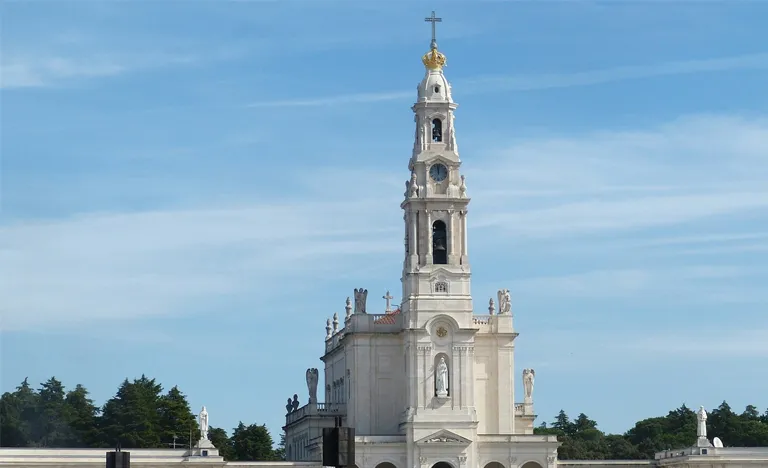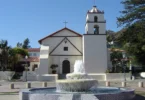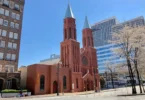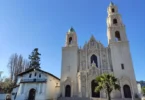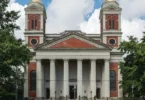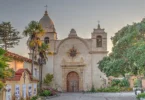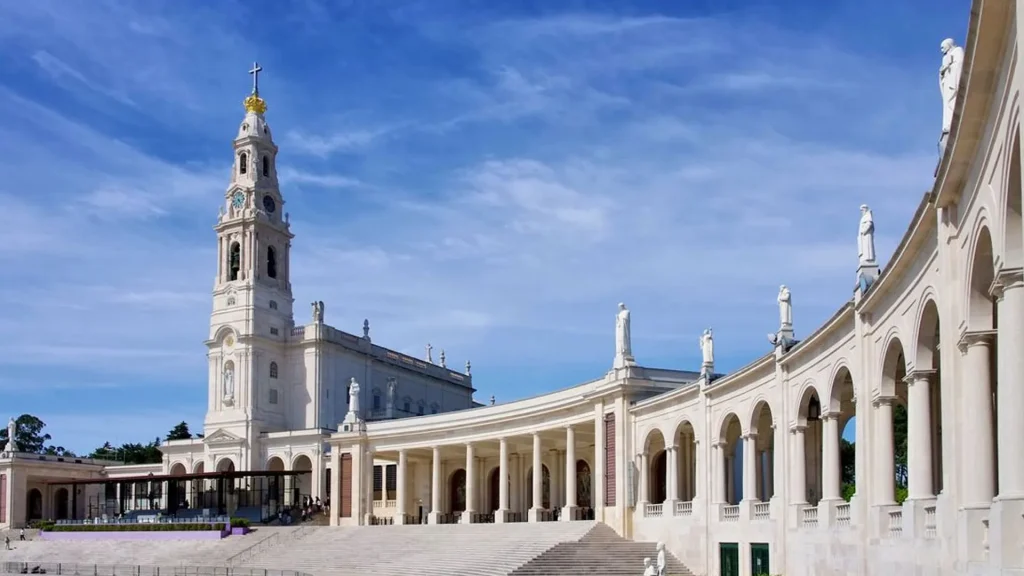
Introduction
The Basilica of Our Lady of the Rosary of Fatima, Portugal is a Roman Catholic church and minor basilica in the Sanctuary of Fátima (Marian Shrine of Our Lady of Fátima) in Cova da Iria, in the civil parish of Fátima, in the municipality of Ourém in Portugal.
Sanctuary of Our Lady of Fátima is the biggest pilgrimage site in Portugal. Located in Central Portugal, the sanctuary of Our Lady of Fátima has become, throughout the years, the fourth biggest catholic pilgrimage site in the world, due to the apparitions of Virgin Mary to three little shepherds in 1917.
In the Sanctuary of Our Lady of Fátima you can also visit the Basilica of Our Lady of the Rosary of Fatima. Built between 1928 and 1953 in a neo-baroque style, the basilica of Our Lady of the Rosary has the tombs of Jacinta and Francisco (1951 and 1952). After the death of Lúcia in 2005, her body was also put to rest in this basilica, side by side with her cousins.
Basilica of the Holy Trinity
The construction of this basilica in the sanctuary of Our Lady of Fátima began in 2004 and ended three years later. With its 8633 seating capacity, this is the fourth biggest catholic church in the world.
This basilica is located in the southwest end of the sanctuary of Our Lady of Fátima, facing the processions area. In the other end (500 metres away) you can admire the basilica of Our Lady of the Rosary and closer you have the chapel of the apparitions.
The Basilica of Our Lady of the Rosary of Fatima
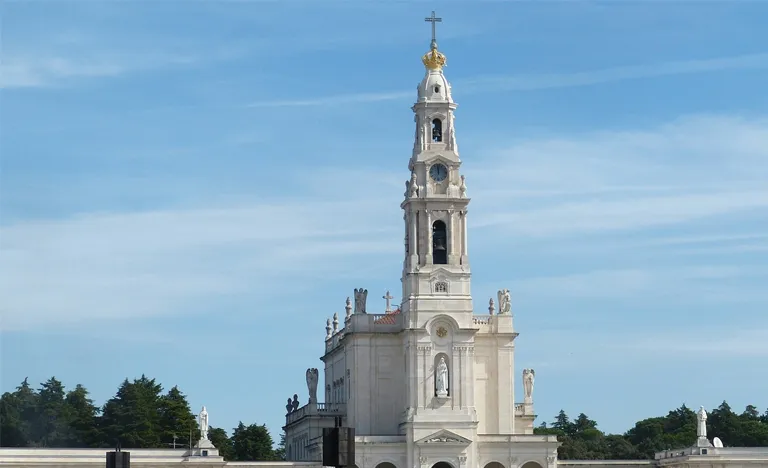
Modern-day visitors to Fatima are able to visit the sites of the apparitions the 1917 visitations of the Virgin Mary. The area of the village known as Cova da Iria, where the apparitions took place, is now the site of the Basilica of our Lady of the Rosary. The highest point of the Basilica reaches 213 feet, while the entire structure includes 62 bells, a large five-section, 12,000-piece organ, 15 altars, an impressive array of stained glass windows depicting moments from the events of the apparitions, and the original sculpture of Our Lady of Fatima as described by Sister Lúcia to the American sculptor, Fr. Thomas McGlynn.
At the heart of the Basilica complex is the Chapel of the Apparition, the epicenter of the visitations and the spiritual heart of the shrine. Other nearby sites include the location where the Archangel Michael, also known as The Angel of Portugal, first came to the three youths.
In its entirety, the Basilica and the complex comprise the largest Marian shrine in the world. Yet the beauty of the site through both the exquisite craftsmanship and the fervor of the devotion of the pilgrims all bear witness to the strength of devotion of the worldwide Catholic community to Our Lady of Fatima.
As months went by, more and more people would appear to witness the apparitions. By the time of the second apparition, about 50 people were present but in the 13th October, during the sixth apparition, there were 50 000 people present to witness the miracle promised by this lady.
The Apparitions
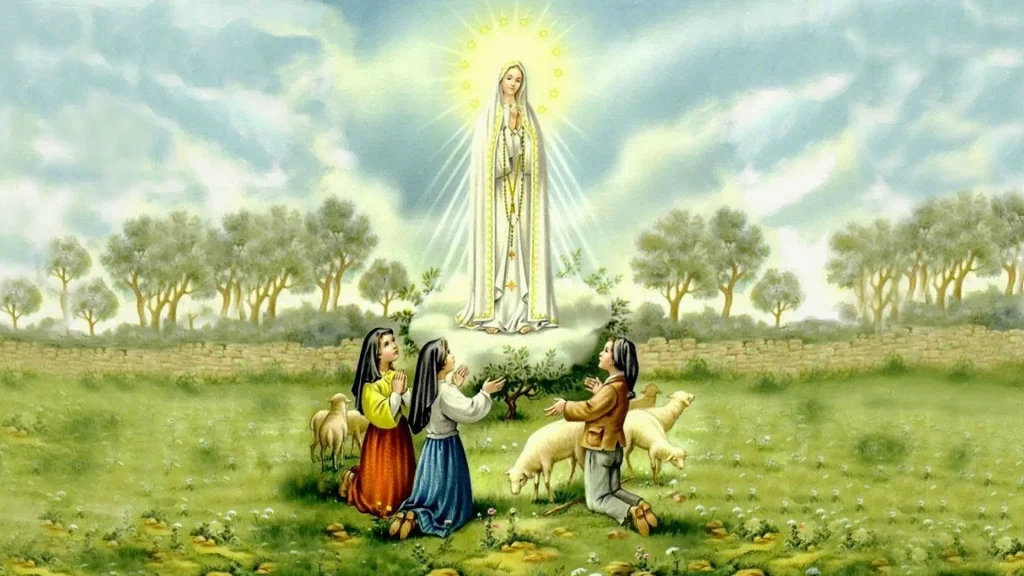
The most significant Marian apparition of the 20th century, Fatima has as much importance for us today as it did back then.
In the spring of 1916, three children took their parents sheep to a pasture in a place not far from the mountain village of Fatima, Portugal. Their names were Lucia dos Santos (age 9) and her younger cousins Jacinta and Francisco Marto (ages 6 & 8, respectively).
They saw a bright light in a cave nearby and a beautiful young man in white garments appeared to the children and announced “fear not, I am the angel of peace…pray with me“. He gave them what became known as the Fatima Prayer.
The following year, on May 13th, 1917 while the children were once again pasturing the flock, this time in Cova da Iria, about a mile from their homes, when a lovely lady appeared to them. After telling the children not to be frightened, she said “I have come from heaven” and told them she wanted them to come to that same place on the same hour on the 13th day of each month until October.
Our Lady continued to appear to the children each month between May and October with messages of great importance for the world and the events to follow, which were to have major consequences and lead many people to Jesus Christ.
The Blessed Mother asked that the children pray the rosary daily, and said that through the rosary wars could be prevented. At that time many men from Portugal were involved in the fighting of World War I.
Fatima involved Three Secrets
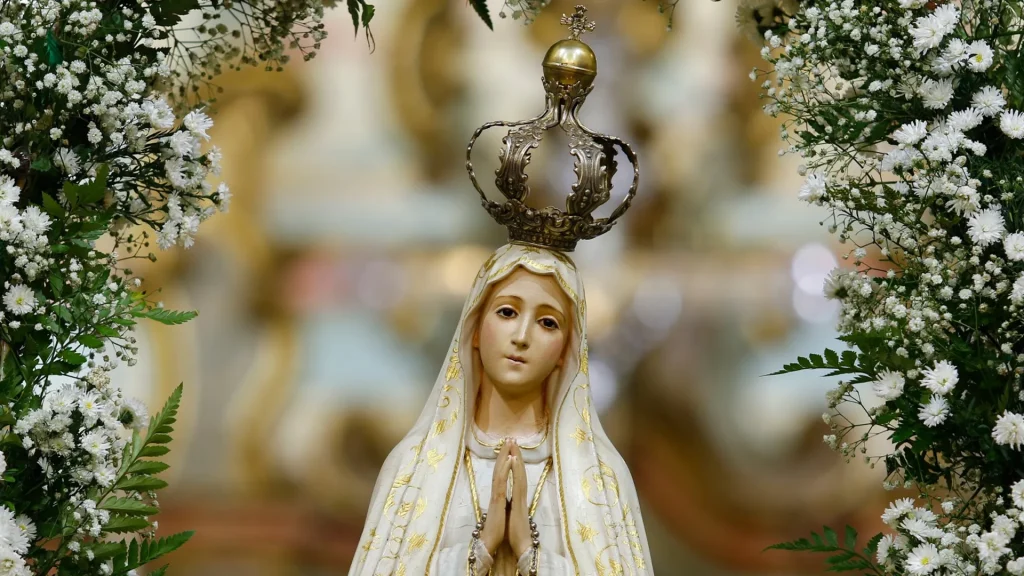
The First Secret : The visionaries were given horrific visions of hell which lasted only a minute. Our Lady showed the visionaries a great sea of fire that they said “seemed to be under the earth. Plunged in this fire were demons and souls in human form, like transparent burning embers, amid shrieks and groans of pain and despair, which horrified us and made us tremble with fear”.
According to the visionaries, the Blessed Mother looked at them sadly and said: “You have seen hell where the souls of poor sinners go. To save them, God wishes to establish in the world devotion to my Immaculate Heart. If what I say to you is done, many souls will be saved and there will be peace”.
Our Lady went on to say: “To prevent this, I shall come to ask for the consecration of Russia to my Immaculate Heart and the Communion of reparation on the First Saturdays. If my requests are heeded, Russia will be converted, and there will be peace; if not, she will spread her errors throughout the world, causing wars and persecutions of The Church. The good will be martyred; the Holy Father will have much to suffer; various nations will be annihilated”.
In that same year, 1917, the communists took over Russia and unleashed a 70 year reign of terror.
Our Lady had gone on to say: “In the end, my Immaculate Heart will triumph. The Holy Father will consecrate Russia to me, and she shall be converted, and a period of peace will be granted to the world”.
The Second Secret : “The war is going to end (World War I), but if people do not stop offending God, a worse one will break out during the pontificate of Pope Pius XI“.
“When you see a night illuminated by an unknown light, know that this is the great sign given you by God that He is about to punish the world for its crimes, by means of war, famine, and persecutions of the Church and the Holy Father”.
Then on the nights of January 25th & 26th January, 1938, the sky across Europe was illuminated with a red light, perhaps the strongest Aurora Borealis ever known to mankind. On February 4, 1938 Hitler promoted himself to military chief in Germany and one week later on March 12, 1938, German troops marched into Austria to annex the German-speaking nation, effectively ushering in the start of World War II, even though it was not officially declared until September 1939.
The Third Secret was the subject of much mystery and even a few conspiracy theories. The third secret was not initially revealed by Lucia. She said that Mary had not yet permitted her to reveal it to the world. In October the Bishop ordered her to put it in writing, which she did, and sealed it in an envelope not to be opened until 1960, when “it will appear clearer”. The text of the third secret was officially released by Pope John Paul II in 2000.
It was interpreted by The Church to be symbolic in nature and referred to the assassination attempt on Pope John Paul II on May 13, 1981……the anniversary date of the first reported Fatima vision. The Pope had just bent down to hug a little girl wearing a Lady of Fatima emblem when the assailant fired, and the bullets struck him in the abdomen rather than the head as planned. John Paul II credited Our Lady of Fatima with saving his life.
The Miracle of the Sun in Fatima
On October 13, 1917 about 70,000 people had gathered on the hillside at the Cova da Iria. Beginning the night before and throughout most of the morning a cold rain fell thoroughly drenching the crowd. The ground was muddy and had soaked everything. At the time when Our Lady was due to arrive, Lucy asked those assembled to close their umbrellas, which they did. Our Lady appeared and told Lucy: “I want to tell you that a chapel is to be built here in my honor. I am the Lady of the Rosary. May you continue to pray the Rosary every day. The war is going to end and the soldiers will soon return to their homes”.
In 1918 on the 11th day of the 11th month at the 11th hour, the armistice was signed ending the “Great War”. As Our Lady ascended, the sky suddenly cleared and the sun danced. The people were able to look directly at the sun without it bothering their eyes at all. The event was reported in the newspaper at the time. The sun then seemed to plunge to the earth and then return to its previous position, terrifying those present.
Yet another astonishing aspect of the miracle was that all of the thousands of people, most of whom were soaked to the bone and dirty with mud, suddenly found that their clothes were dry. A physician who was present, Dr. Almeida Garrett, testified: “Suddenly I heard the uproar of thousands of voices, and I saw the whole multitude spread out in that vast space at my feet…I turned around too, toward the point commanding their gaze, and I could see the sun, like a very clear disc, with its sharp edge, which gleamed without hurting the sight or damaging the retina”.
The great miracle of the sun lasted about 10 minutes, but the results of this miracle continue today, as Fatima draws millions of pilgrims from around the world every year, and had even more in 2017….the 100th anniversary of the apparitions. The newspaper article shown to the left was actually an anti-Catholic paper, and yet they published the events.
The Fate of the Children
Francisco and Jacinta both died young, as prophesied by Our Lady: she had told them they would be taken to Heaven early. Francisco died at age 10 and Jacinta at age 9. Francisco and Jacinta were canonized Saints by Pope Francis on May 13th, 2017, the 100th anniversary of the first apparition, and their feast day is February 20th.
Lucia went on to become a Discalced Carmelite nun (taking the name Sister Maria Lucia of Jesus and of the Immaculate Heart). She lived at the convent in Monastery of Santa Clara in Coimbra, Portugal (about 53 miles north of Fatima). There is a small museum detailing the life of Sister Lucia. She had been blind and deaf, and ailing for some years, when she died on February 13, 2017. Sister Lucia was accorded the title Servant of God, as the first major step toward her canonization.
The Three Little Shepherds Houses
Two kilometres away from the sanctuary of Our Lady of Fátima, in a place called Aljustrel, you’ll find the location where the three little shepherds lived. In the house of Francisco and Jacinta you can admire furniture from that time and objects from everyday life; you can even take a picture in the exact spot where the three little shepherds were photographed – a photo known worldwide.
Lúcia’s house is 150 metres away from her cousins’. Here, you can find a museum that offers to visitors the possibility to learn more about the life in the 20th century.
About the Shrine at Fatima
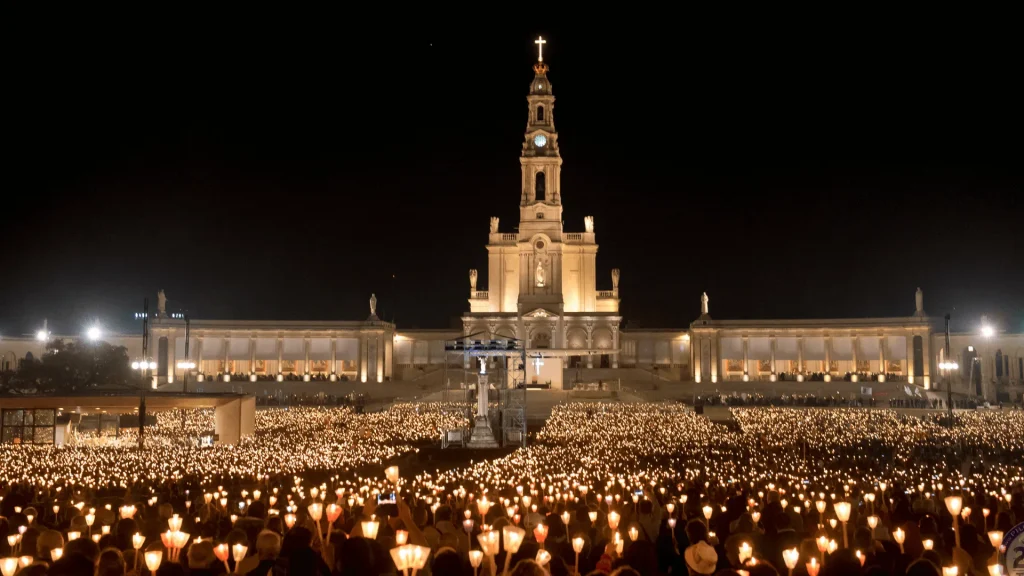
The Big Holmoak : The tree under which the children and the early pilgrims sat and prayed the Rosary as they awaited Our Lady’s appearance. It is right behind the Chapel of the Apparitions.
The Basilica of Our Lady of the Rosary : The focal part of the Fatima shrine, this Basilica was constructed in the Baroque Revival Style, features Stained glass windows that depict the events of the apparitions. There are 14 side altars within the church, each one dedicated to one of the fourteen mysteries of the Rosary and represented in bronze, Bas-reliefs. The 15th mystery is represented in the vault of the presbytery and is a high-relief by Maximiano Alves. The Basilica houses the tombs of Saints Francisco and Jacinta. Upon her death in 2005, Sister Lucia’s body was also entombed here.
The Perpetual Adoration Chapel : Located at the end of the collonade of the Basilica of the Rosary.
The Basilica of the Holy Trinity : Constructed in 2007, it is across from the Basilica of Our Lady of the Rosary and contains five chapels, 16 confessionals and a cafeteria. It will help to accommodate the millions of people who visit here each year.
House of Our Lady of Dolours (Our Lady of Sorrows) : Located next to The Chapel of Apparitions, it is destined to receive the sick during the great pilgrimages, and also used for retreats and accommodation for pilgrims.
The childhood homes of the visionaries : In nearby Aljustrel, they remain much as they were in 1917. The bedrooms of the young visionaries remain much as they were at the times of their deaths. Relatives of the visionaries are still seen around in the village, as the photos below show.
A portion of the Berlin Wall : At the entrance of the Sanctuary, on the south side of the Rectory, a testament to the fall of Communism and the triumph of Our Lady.
Chapel of the Apparitions
One of the places you must visit in the sanctuary of Our Lady of Fátima is the chapel of the apparitions. This small chapel was built in 1919 on the exact spot where the tree was rooted (the oak tree disappeared soon after the apparitions due to pilgrims that cut its branches to keep a part of this “relic”), next to which the Virgin Mary appeared to the three little shepherds.
Although it was destroyed by strangers in 1922, the small chapel was rebuilt some months later.
In 1982, a big roof was added to the small chapel to protect the pilgrims from the hot days and rainy days.
In the centre of the chapel you’ll find the original statue of the Virgin Mary (1920). In its crown you can find the bullet that hit the Pope John Paul II in the assassination attempt in Rome in the 13th May 1981.
In some days of the year, masses are celebrated in this chapel and rosaries are prayed with live broadcasts on the Internet.
The Saints
Francisco and Jacinta died a few short years later in 1919 and 1920 from influenza, but insisted that they had been foretold their coming departure from the world. Canonized as Saints in 2017 Pope Francis after a popular appeal, their cousin Lúcia became a Carmelite nun who remained devoted to her religious community until her death in 2005, and is at present considered a “Servant of God” by the Catholic Church; the first step towards sainthood.
A Place of Pilgrimage
So remarkable and life-changing were the events surrounding the experiences of the three youths that the village of Fatima and its environs quickly became a place of pilgrimage; a tradition that continues to the present day. Up to eight million pilgrims and visitors come to Fatima each year, easily making it one of the most visited pilgrimage sights of the Catholic faith along with Rome, the Holy Land and Lourdes.
Feast Day – 13th May
May 13th is celebrated by the Catholic Church as the Feast Day of Our Lady of the Holy Rosary of Fatima. It marks the first day in 1917 on which the Blessed Mother appeared to the three shepherd children of Fatima in Portugal.
Mass Time
Everydays
- 7:30 am
- 6:30 pm
Contact Info
Basilica of Our Lady of the Rosary of Fatima,
Rua de Santa Isabel, 360
2495-424 Fatima, Portugal
Phone No.
Tel : (+351) 249 – 539 600
Accommodations
Traveling to Fatima
There are many Catholic tour groups to Fatima each year. If you are traveling independently, Fatima is located about 70 miles north of Lisbon, and you can go by car or train. If you plan to go by train, trains leave from Oriente station in Lisbon and take about one hour to Caxarias, the nearest station From there, shuttle buses connect to Fatima.
If you want to visit the sanctuary of Our Lady of Fátima, the caves, the natural park and the beautiful monuments in Tomar and Batalha, then I suggest that you take your own car (there is even a highway exit near the sanctuary).
You can also take the bus in Lisbon or in Porto. Fátima also has a train station but it is located 20 km away from the sanctuary.

